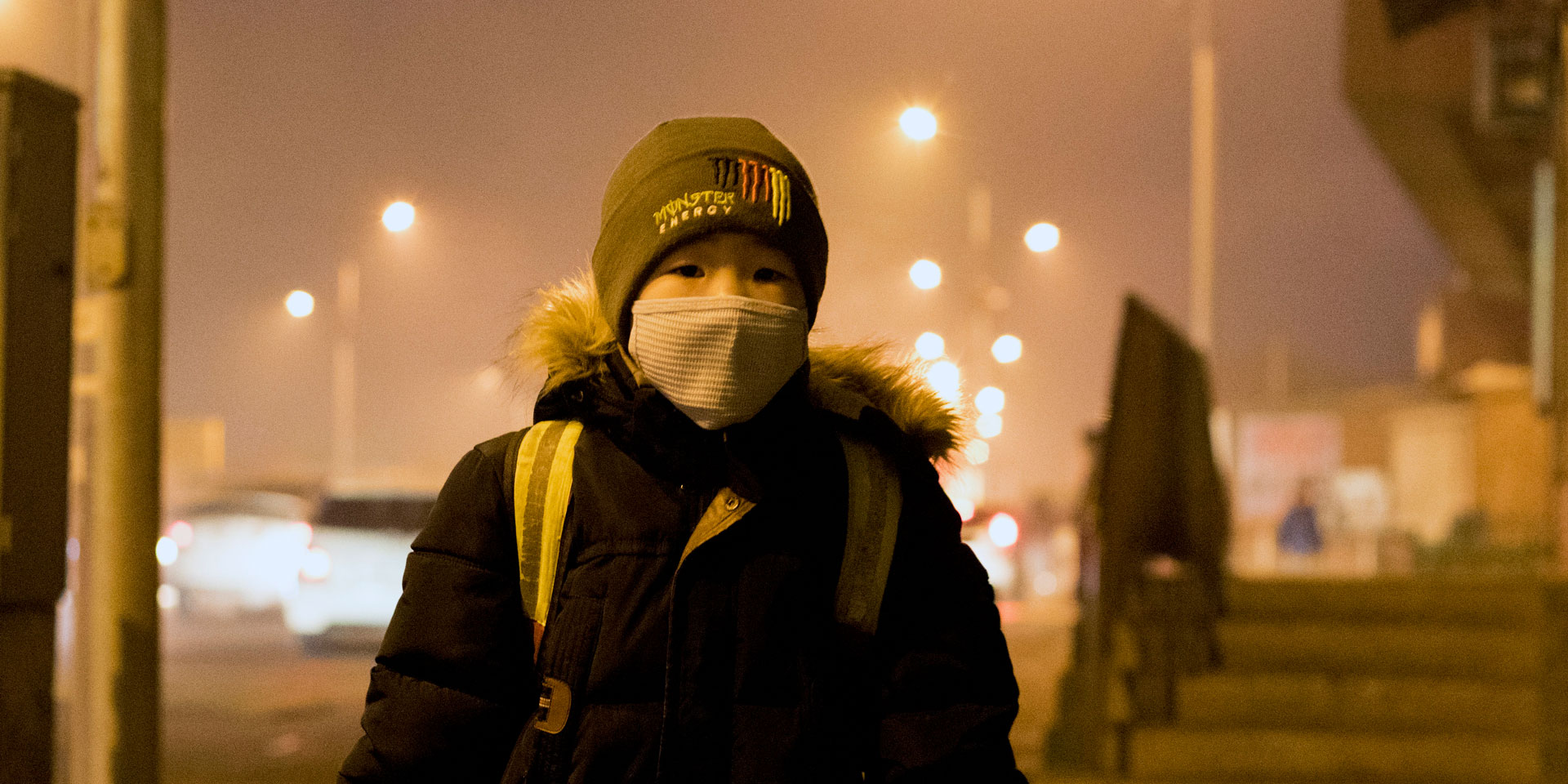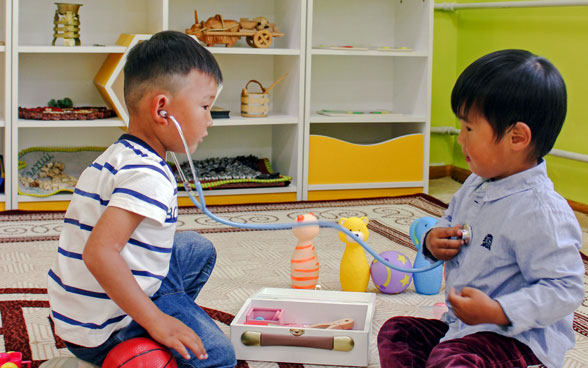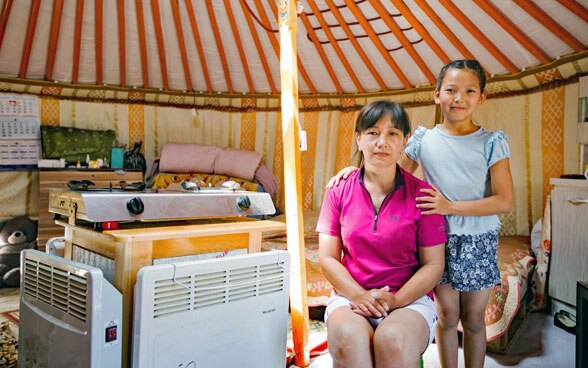Breathing new life into Mongolia: Addressing air pollution challenges
Ulaanbaatar, the world's coldest capital, faces a significant threat from air pollution. The need for heating results in hazardous smog, leading to severe health issues and resulting in 300 fatalities annually. Switzerland supports transformative projects and innovative solutions such as the refurbishment of schools and kindergartens and providing the CHIP (Cooking Heating Insulation Package) products.

A boy with a school rucksack and face mask stands waiting at a bus stop in Ulaanbaatar. © SDC / Davaanyam Delgerjargal
«Air pollution poses one of the biggest threats to Mongolia’s future», says Stephanie Burri, head of Swiss Cooperation in Ulaanbaatar. Currently, in Mongolia, 300 people die each year due to air pollution-related illnesses, 240 of whom are children under the age of five. Children, pregnant women, and elderly are the most negatively impacted, but air pollution harms the entire population.
In Mongolia, the death rate due to air pollution is 132 per 100,000 people annually, compared to the global average of 92 per 100,000 people. Each year, when winter comes to Mongolia, air pollution is at its highest. With temperatures of up to -45 degrees Celsius, there is a dire need for heating buildings and having a warm home. 80 percent of air pollution is caused by burning coal in traditional felt dwellings called yurts or gers. Heating with coal comes with significant risks, as it leads to high levels of indoor and outdoor air pollution. The annual mean concentration of PM2.5 in the air in Ulaanbaatar remains 6 to 10 times higher than the level considered safe by WHO guidelines. During the winter months (from November to March), the mean concentration of particulate matter is 8 to 14 times higher than the WHO guideline values.
One of the effective steps to reduce air pollution is the improvement of infrastructure and the reduction of energy losses in buildings, explains Burri. LEEAP, the Local Energy Efficiency Action Plan for Mongolia’s capital city, Ulaanbaatar, which was supported by Switzerland, brought substantial results in improving the building sector. Through a multi-level approach, the project led to greater energy efficiency and effective and efficient public investment management. With Swiss funding, 28 schools and kindergartens were refurbished. The results are stunning. The data shows that the number of sick children decreased by up to 48%, and in this case, teachers’ sick leave was reduced by 78% compared to 2017.
Confronting urban challenges

Not only Ulaanbaatar, where 48% of the population lives, but most cities in Mongolia struggle with enormous heat loss from their buildings, resulting in high energy consumption. Many were built decades ago and have not been maintained over the years. Thus, most infrastructure shows poor insulation and low building standards. As of 2020, Ulaanbaatar was home to 411,000 households, 221,000 of whom lived in yurts or gers in peri-urban settlements called ger districts. They are mostly off-grid areas with limited access to electricity, water, sanitation, heat supply, and public transport. People living there are particularly affected by air pollution. Nearly 800,000 people in Ulaanbaatar live in ger districts, demonstrating the huge need for adequate housing and heating.
Transforming health: successful health initiatives

A successful solution to this problem is the project “Impact of Air Pollution on Maternal and Child Health Project,” which was completed in 2023. The SDC commissioned UNICEF Mongolia to implement the four-year project and contributed almost CHF 5 million to the project. “With different key players, Switzerland has significantly contributed to improving primary healthcare facilities and their services for children and pregnant women to cope better with indoor air pollution and reduce the incidence of pneumonia among children and air pollution-related pregnancy risks,” says Stephanie Burri.
A comprehensive solution offered to ger residents is the Cooking, Heating, and Insulation Products (CHIP) package, which includes insulation, electric heating, and ventilation. This integrated approach not only directly reduces indoor air pollution but also yields broader societal benefits. It positively influences social and gender equality by enabling households to save on heating expenses. CHIP's time efficiency, in comparison to traditional stoves, translates to significant time savings for women and children, exceeding 40 minutes daily. Furthermore, CHIP reduces children's exposure to household burns. This transformation to clean technology has benefited 72.6% of the households living in Mongolia's urban areas.
Empowering communities: social solutions for clean air
Addressing the health crisis can also be approached from a social perspective. One key aspect is to inform the population about the harms of air pollution and provide adequate guidelines to protect themselves. Those might be to wear certified face masks, to use a window filter, or eat foods rich in vitamins and Omega‑3 fatty acids. A pilot programme of community-based health workers has demonstrated its effectiveness in reaching families in remote ger settlements. These health workers deliver vital information from health clinics, share guidelines, impart skills for recognising dangerous signs of newborn diseases, protect them against air pollution, and facilitate subscriptions to prenatal and neonatal health services, among other initiatives. Given the pilot's success, this approach is now being expanded nationwide.
Moreover, small solutions can lead to significant gains. For instance, indoor air quality monitoring devices have played a crucial role in dispelling the misconception that only outdoor air poses risks. It emphasises the need to address indoor air quality as well. Thus, air ventilation systems were installed in six kindergartens, so today, more than 1,500 children can breathe clean air in their kindergartens.
Counting the costs: economic impact
Mongolia's health crisis impacts the private sector, notably reducing productivity in winter due to increased absenteeism from employee and child illnesses. Cold buildings, especially where heat loss is high, further exacerbate issues, affecting comfort for studying, working, and services. This results in decreased productivity, health, and overall life quality.
The economic toll is substantial, estimated at a staggering USD 645 million annually, equivalent to 4.6% of Mongolia's GDP in 2022. The government has responded with crucial changes under the National Programme for Reducing Air and Environmental Pollution, including:
- Ban on raw coal use in Ulaanbaatar
- Nighttime electricity tariff discounts in ger districts
- Green loans for households to adopt eco-friendly solutions and CHIPs
- New building standards for hospitals and kindergartens to eliminate indoor air toxicity
- Support for the shift to electric heating
- Replacement of coal-fired heat-only boilers in public buildings with cleaner alternatives.
These measures resulted in a notable 40% reduction in fine particulate matter PM2.5, a contributor to respiratory diseases.
